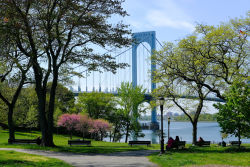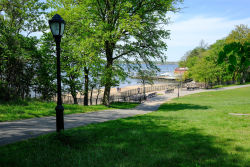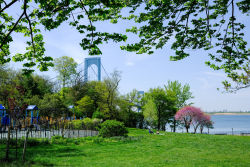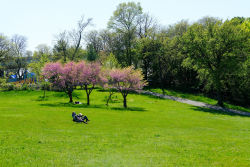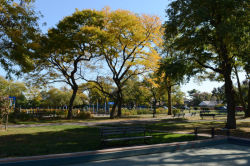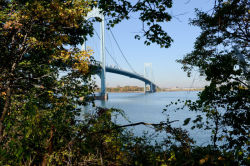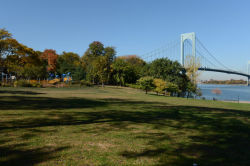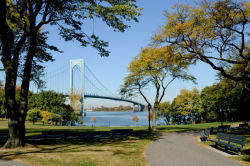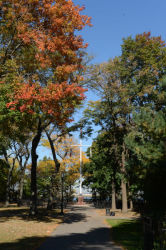Francis Lewis Park
Francis Lewis Park
What was here before?
Dutch farmers founded Whitestone in 1645, naming the area for a large, white limestone boulder along the shore. Purportedly, the Dutch purchased the land from the Matinecock at the price of one ax per fifty acres.
In 1765 the British granted this land to Francis Lewis, a Welsh-born merchant, as acknowledgment for his service in the French and Indian War. After his death in 1802, the property was eventually owned by farmer George L. Smith. His descendent H. DeWitt Smith inherited the estate and property around the turn of the 20th century. By this time the waterfront was known as Smith’s Shore. It remained with the Smith family until the 1930s when it was purchased by Edwin H. Brown.
How did this site become a park?
In 1937, Parks purchased the land from Brown. At that time that the Smith house was demolished to make way for park development and the construction of the Bronx-Whitestone Bridge (1939), designed by Othmar H. Ammann, which crosses over the western side of the property.
The park consists of winding paths that lead to two scenic overlooks equipped with benches and game tables. Both overlooks feature spectacular views of the bridge and the East River, while the lower overlook provides beach access.
In 1992, Francis Lewis Park’s shoreline, overlook, and embankments were rebuilt to correct a severe erosion problem, prevent future degradation, and improve views of the river. In 1999 bocci courts were added to the park. The commemorative flagstaff, which dates to 1939 and includes a bronze plaque dedicated to the park’s namesake, and the surrounding plaza at the upper overlook were restored in 2023.
Who is this park named for?
This park honors Francis Lewis (1713-1802), an early American merchant, patriot, and signer of the Declaration of Independence. Born in Llandaff, Wales, Lewis became an orphan at a young age. He completed a merchant apprenticeship in London and then traveled to America in 1738. In 1745, Lewis married Elizabeth Annesley, the sister of a business partner.
The entrepreneur established a successful trading company in both New York City and Philadelphia and grew rich by supplying goods to British troops during the French and Indian War (1755-1763). He was imprisoned in 1756 while at a fort that was attacked by the French. He was released seven years later and the British government compensated him with 5,000 acres of land in New York. Having accumulated great wealth, Lewis retired from trade in 1765 and moved to his newly acquired property in Whitestone. Lewis took issue with taxation without representation, and it turned him to the Revolutionary cause.
Lewis’s political career began in 1774, when he served as a New York delegate to the Provincial Convention. The convention elected Lewis to the Continental Congress, where he served from 1775 to 1779. On July 4, 1776, Lewis signed the Declaration of Independence, which proclaimed the colonies forever absolved from allegiance to the British crown. In the fall of 1776, the British destroyed Lewis’s Whitestone property and abducted his wife Annesley. After her release, she died prematurely in 1779, perhaps due to the harsh conditions of her captivity.
During the Revolutionary War (1776-1781), Lewis served on two powerful committees: the Secret Committee, which imported munitions, and the Marine Committee, which administered naval affairs. Defeated for re-election to the Continental Congress in 1779, Lewis nevertheless was appointed to the Board of Admiralty, which replaced the Marine Committee. In the years before his death, Francis Lewis served as a vestryman for Trinity Church in New York City.
Check out your park's Vital Signs
Clean & Safe
Green & Resilient
Empowered & Engaged Users
Share your feedback or learn more about how this park is part of a
Vital Park System

